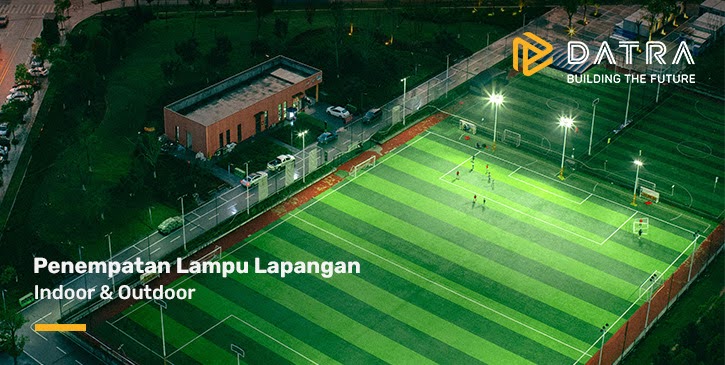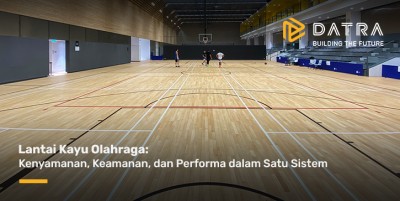Indoor and Outdoor Sports Field Lighting Placement
Education
May 14, 2025

Lighting is not just a matter of light or dark. In the world of sports, lighting is the backbone of comfort, safety and optimal performance. Whether for players, spectators, or broadcast media, the quality of lighting can be the difference between an interesting match to watch or not.
This Datra article will discuss more about sports field lights for both indoor and outdoor. After reading this article you will understand that sports field lights are one of the main components of a sports field. Let's discuss it more fully.
Differences in Indoor vs Outdoor Lighting Needs
Indoor and outdoor sports field lights actually have the same function. The main function of this lamp is to illuminate the field so that sports can be done safely and comfortably.
The main differences between indoor and outdoor field lights are as follows:
- Indoor courts have full control over the light, allowing for more precise settings.
- Outdoor courts face the challenges of weather, natural light fluctuations, and environmental light interference.
These differences can be used as a benchmark for design and fundamental placement and positioning of lights.
Also Read: Getting to Know Tennis Padel Courts
International Standards for Sports Field Lighting
International sports lighting standards are not only technical guidelines, but also an important foundation in professional sports field design.
Global sports organizations such as FIFA, FIBA, BWF, and international standards bodies such as CIE (Commission Internationale de l'Éclairage) and IESNA (Illuminating Engineering Society of North America) have set strict and very specific lighting parameters.
The aim is to ensure maximum visibility for players, officials, spectators, as well as being optimal for high quality television and media broadcast purposes.
Key Components in Sports Lighting Standards
International standards generally regulate the following key aspects:
- Illuminance level: Measured in lux (lx), this indicates how bright the field surface is. The lux level is adjusted based on the type of sport, the level of competition, and whether or not the match is being broadcast live.
- Uniformity: Refers to how evenly distributed the light is across the pitch. Standards require a Uniformity Ratio of at least 0.5 to 0.7 depending on the sport.
- Glare Rating (GR): This measures the level of glare that players or spectators feel due to uncontrolled lighting. The lower the value, the better.
- Color Rendering Index (CRI): CRI determines the ability of light to reproduce colors accurately. Broadcast TV, especially HD or 4K, requires a CRI ≥ 80 for uniform, ball, and field colors to look sharp and natural.
- Color Temperature (CCT): Usually in the range of 4000K to 6500K, depending on the desired visual atmosphere. For broadcasting purposes, a color temperature of around 5700K is generally used.
Example Standards by Sport
FIFA (International Football Federation)
- Amateur matches: minimum 500 lux
- Professional matches: minimum 1000 lux
- International matches + HD broadcasts: 2000 lux and above
- Minimum uniformity: 0.7
- CRI: ≥ 80
FIBA (International Basketball Federation)
- Local competitions: 750 lux
- National/International: 1500-2000 lux
- The lighting system should avoid harsh shadows and have electrical backups to avoid blackouts during matches.
BWF (Badminton World Federation)
- 1000-1500 lux for national matches
- 1500-2000 lux for live matches
- Strict glare control is required as the shuttlecock is very small and fast.
ITF (International Tennis Federation)
- TV broadcasts require 1000-1500 lux
- For night tennis, lighting should accentuate the direction of the ball and not interfere with the player's viewing angle when serving
Read More: 10 Nominated Stadiums for the U-20 World Cup in Indonesia
Factors Affecting Lighting Placement
Lighting placement on a sports field is not an arbitrary decision. It is the result of technical calculations, visual considerations, and adaptations to various structural and functional elements.
Each light position has direct consequences on lighting quality, visual comfort, and energy efficiency. Let's take a comprehensive and in-depth look at the factors that influence the placement of lights in sports arenas, both indoor and outdoor.
Type of Sport and Player Movement Patterns
Each sport has different movement characteristics, and these largely determine the direction, intensity and coverage of the lighting.
- Football demands wide and uniform lighting as the ball can move from end to end of the field quickly.
- Badminton, on the other hand, demands focused, sharp and glare-free lighting as the shuttlecock can soar high and change direction at extremes.
- Basketball requires lighting that follows the dynamic and intense rhythm of the game in the center area.
Understanding the course of the game is the basis for determining the installation point, the height of the lights, and the angle of illumination.
Field Size and Shape
Field dimensions are directly proportional to the number and distribution of lights. Small fields such as indoor futsal can use a grid configuration with low mounting. While large fields such as outdoor soccer require tall poles and a certain angle of inclination so that the light reaches the entire field.
Meanwhile, the shape of the field is rectangular, oval, which also determines the direction of the light beam and the lighting focus area.
Ceiling or Light Pole Height
The height of the light installation determines the distribution and strength of the light. Too low, the light becomes intense and dazzling. Too high, the light spreads too widely and loses efficiency making it too dark.
- In indoor courts, low ceiling heights require lights to be angled with diffusers or louvers.
- In outdoor venues, 12 to 30 meter high poles are used for even light distribution without producing annoying long shadows.
Surface Color and Reflectivity
Ground, wall, and roof surfaces have the ability to reflect light. Materials such as vinyl, wood, or concrete can affect how bright an area looks. Fields with dark-colored walls require higher light intensity than light surfaces that reflect more light.
Obstructions
Steel beams, support poles, air conditioning vents, and even scoreboards can be obstacles in light distribution. Therefore, the position of the lights should avoid areas that may cause unwanted shadows or reflections.
Natural Lighting
There are several additional variables in outdoor and indoor site lighting, such as sunlight, windows, and the sky.
The placement of lights must take into account the direction of sunlight in the morning, afternoon, and evening so as not to create excessive contrast between natural and artificial light.
One solution is with an automatic control system that can adjust the intensity of the lights based on the ambient lighting conditions (lux sensor).
Also Read: Basketball Court Standard Size
Types and Specifications of Lights Used
Usually sports lights use types such as LED, HID (High Intensity Discharge), or Halogen. All three have different lighting characteristics in terms of distribution.
- LED and HID are more flexible in placement because they can be adjusted in angle (variable optics) and do not overheat.
- Halogen takes time to warm up and is not suitable for low placement as the light is very dazzling.
Beam Angle - Beam angle determines the area that can be reached by one lamp. A lamp with a narrow beam angle is suitable for intense focus, while a wide angle is for broad light distribution.
The placement of lights must consider the overlap between beams so as not to leave dark areas on the surface of the field.
Requirements from Regulations and Certifications
Some standards such as those from FIFA, FIBA, or BWF require lights to be installed in a certain configuration to pass inspection. This affects the height, direction, and type of bracket used in the placement of the lights.
Safety Considerations and Maintenance Access
Lights should be placed in areas that are safe from the risk of ball impact, player interference, and easily accessible when maintenance is required. Placement too high without elevator or gondola access can add to long-term operational costs.
Kesimpulan
Penempatan lampu di lapangan olahraga bukan hanya perkara teknis, tapi juga seni menggabungkan fungsi, efisiensi, dan kenyamanan visual. Ia adalah titik temu antara teknologi pencahayaan modern dengan kebutuhan atletik dan hiburan. Setiap keputusan, dari sudut pemasangan hingga arah pancaran, harus diambil dengan cermat dan berbasis data, bukan hanya insting. Karena dalam dunia olahraga, satu detik dalam gelap bisa berarti satu kekalahan.
Datra Internusa siap membantu Anda membangun lapangan olahraga impian. Kami siap menjadi partner konstruksi di dunia olahraga. Anda bisa melakukan konsultasi secara gratis mengenai berbagai jenis pembangunan lapangan dan fasilitas olahraga baik outdoor atau indoor. Hubungi Datra sekarang juga!


